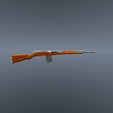The AVS-36 (Russian: Автоматическая винтовка Симонова образца 1936 года (АВС-36); Avtomaticheskaya vintovka Simonova obraztsa 1936 goda (AVS-36); "Automatic rifle Simonov model 1936 (AVS-36)") was a Soviet automatic rifle which saw service in the early years of World War II. It was among the early selective fire infantry rifles (capable of both single and full-automatic fire) formally adopted for military service.
History
Origins
The designer, Sergei Simonov, began his work on a gas-operated self-loading rifle in 1930. The first prototype was ready in 1931 and appeared promising. Three years later a trial batch of an improved design was made. In 1935, a competition between Simonov's design and a rifle made by Fedor Tokarev was held. The Simonov rifle emerged as the winner and was accepted into service as the AVS-36. The AVS-36 was first seen in public in the 1938 May Day parade in Moscow, when it was displayed by the marching 1st Rifle Division. The American public became aware of it when it was covered in the August 1942 issue of the American Infantry Journal, in an article by John Garrett Underhill Jr.[5]
Service
Once in service, it quickly became apparent that the AVS was not a satisfactory design; the operating mechanism was overcomplicated, and the problem was made worse by the rifle's construction which let dirt get inside the weapon. The rifle was also particular about ammunition quality. The muzzle brake design proved to be quite successful, as the rifle had very little overall climb, however its intense recoil impulse still meant the rifle was impractical in automatic fire. Some of the problems with the rifle in the field were thought to be the magazine, which was deemed too long. Production of the AVS-36 was terminated in 1940 after about 34,000 were produced,[6] and a new design competition was held to which Simonov and Tokarev submitted their improved designs.
In 1938, Tokarev's SVT-38 was also adopted for service. In 1939 a politicized dispute erupted within the Soviet elite as to which design, that of Simonov or that of Tokarev, should prevail. Simonov's rifle was lighter and contained fewer parts, while Tokarev's rifle was considered sturdier, although this was mainly due to firing pin breakages on Simonov's rifle. Both guns had their supporters and detractors among the Politburo. Stalin ultimately sided with Tokarev, with whom he had a good personal relationship. By a decision of the Defense Committee dated 17 July 1939, mass production was to concentrate on the SVT-38.[7]
Red Army World War II rifles. L–R: Mosin–Nagant M/91-30, Mosin–Nagant M/38 Carbine, Mosin–Nagant M91 Dragoon Rifle, AVS-36, and SVT-38.
Official Soviet production breakdown figures are: 106 made in 1934, 286 in 1935, 10,280 made in 1937, 24,401 in 1938, with an estimated total of 65,800 AVS-36s manufactured until production stopped in 1940 (exact production figures for some years, like 1936 or 1939, is not reported).[5]
The new weapon would be tested during the Spanish Civil War when small numbers were shipped to Republican forces.[8][9]
World War II and beyond
The rifle first saw service in the Battle of Khalkhin Gol, and later in the Winter War, but did not perform well. Some of the problems were caused by incorrect maintenance; many rifles went into combat without having been cleaned of their storage grease, which then "froze" solid.[citation needed] About 300 AVS-36 examples were captured by the Finns;[10] some were used by their new owners.[11] The SVT-38s and LS-26s used on the Finnish side suffered from similar problems. After a large amount of the more serviceable SVTs were captured, the AVS-36s were largely withdrawn from service.[citation needed] In the Soviet Union, the AVS was quickly marginalized and apparently withdrawn from service during 1941, though it saw brief service during World War II. Some reports claim that remaining AVSs were mostly scrapped. The US Ordnance Corps tested the weapon in the early 50s along with several SVT rifles. They noted that in addition to the Soviet's findings, the weapon's gas system, which had a sleeve that moves around the rear sight, also had a habit of loosening the rear sight over time resulting in inaccuracy.[12] Today, the AVS-36 is a rare collector's item; most of the remaining rifles in existence are in Finland.
Simonov would later design an anti-tank rifle, the PTRS-41, and the SKS carbine, which employed simpler tilting bolt operation.
I have set them to a 1:35/1:72 ratio for easy printing, and the size comes from the data provided by the encyclopedia. You can adjust its size to any place by yourself.
Note: If using the model for 3D printing, model repairs may be needed.

/https://fbi.cults3d.com/uploaders/27658003/illustration-file/c6e56432-227a-41a3-8e05-e30b02434045/avs_36_-3840x2160.png)



















